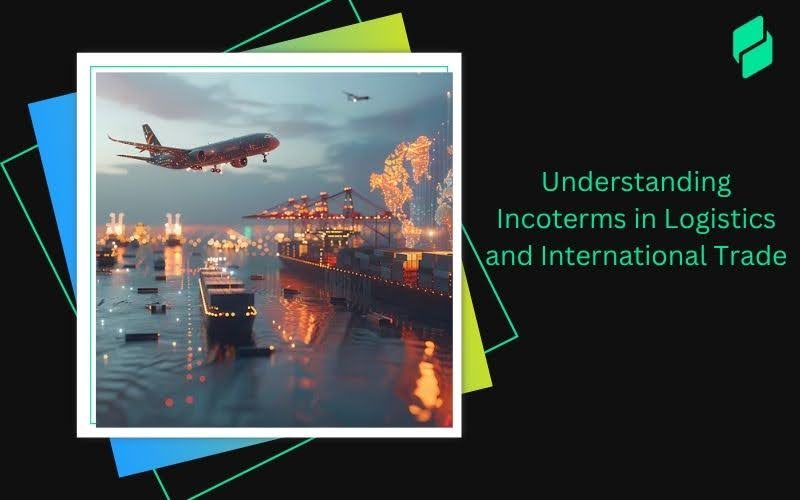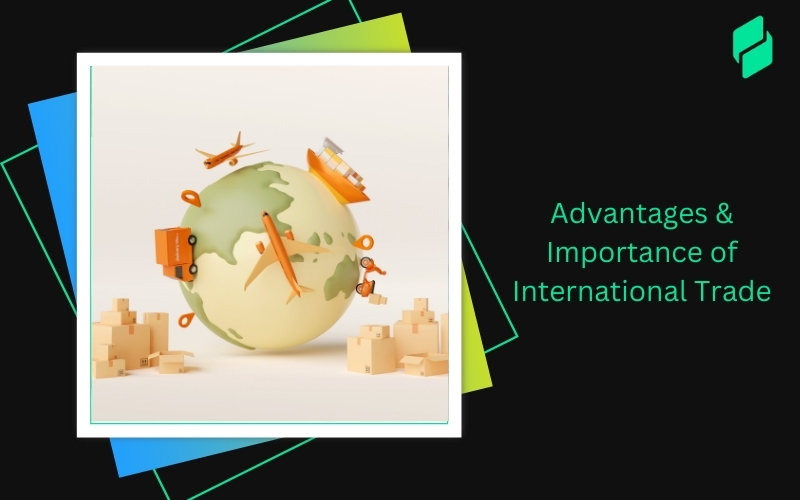Optimize your business: use unlimited savings with Pazago fulfilled now!
Get Started ->Did you know that every international shipment carries a built-in rulebook? Before a product clears customs or hits the deck of a ship, it travels through a legal and logistical framework set by globally accepted trade terms. These rules, known as logistics Incoterms, define the scope of responsibility, liability, and cost between buyer and seller.
Incoterms are widely used across global trade to standardize terms between international buyers and sellers. In India, logistics costs were estimated at around 10% of GDP in 2024, down from 14%, reflecting improvements in infrastructure and freight efficiency. To stay competitive, Indian exporters must eliminate ambiguities in trade contracts and optimize supply chain processes.
This blog will break down the structure and substance of Incoterms, highlight the key updates in the latest version, and explain how to effectively utilize these shipping terms to ensure clarity and efficiency in every contract.
What Are Incoterms?
Incoterms (International Commercial Terms) are standardized trade definitions created by the International Chamber of Commerce (ICC) to clarify the roles of buyers and sellers in international transactions. They help prevent disputes by outlining who handles tasks like packaging, freight, insurance, customs clearance, and duties.
Each Incoterm defines the point at which risk transfers from seller to buyer, whether at the seller’s warehouse, a port, or the buyer’s location.
First introduced in 1936, Incoterms have been updated to reflect changes in global trade. The latest version, Incoterms 2021, addresses digital commerce and evolving logistics practices. It remains a key tool in contracts, customs documents, and supply chain planning.
To fully understand how Incoterms support global trade, it’s important to explore the specific areas they cover. These standardized rules clarify critical aspects of international shipping, from the division of costs and responsibilities to the point at which risk transfers from seller to buyer. Let’s break down each of these areas in detail below..
What are the Areas Covered by Incoterms?
Incoterms define the operational boundaries in an international sale. While they don’t address every commercial clause, they govern six critical areas that shape trade execution:
1. Delivery Obligations
Incoterms specify who arranges transport, handles loading and unloading, and where goods must be delivered. For example, under DDP (Delivered Duty Paid), the seller delivers goods to the buyer’s site, including unloading and duty payments.
2. Risk Transfer Points
Each Incoterm defines when risk shifts from seller to buyer, whether at the seller’s location, on the vessel, or at delivery. This clarifies liability and supports insurance planning.
3. Cost Allocation
They assign responsibility for freight, insurance, duties, taxes, and handling fees. This prevents disputes and improves cost transparency for better budgeting.
4. Export and Import Responsibilities
Incoterms clarify who manages export clearance, import permits, and customs paperwork. This ensures compliance and reduces the risk of border delays.
5. Mode-Specific Handling
Some Incoterms apply only to sea transport (e.g., FOB, CIF), while others cover multimodal shipping (e.g., FCA, CIP). This helps partners choose terms that match their transport method.
6. Insurance Requirements
Certain terms (like CIF and CIP) require one party to provide minimum insurance. This protects goods during transit and limits financial exposure.
These terms offer a shared reference for legal, procurement, and logistics teams. When used correctly, they simplify operations, cut costs, and strengthen trust between trading partners.
Also Read: Exim Logistics Management
So, why do incoterms matter in logistics? Let us discuss in more detail below.
Why Logistics Incoterms Matter
In international logistics, clarity eliminates conflict. Incoterms shipping terms create a uniform language across legal systems and trading cultures. These terms are not legal mandates, but universally accepted commercial tools that reduce friction in cross-border trade. When correctly applied, they:
- Clarify Roles and Responsibilities: Clearly define buyer and seller duties for each delivery step to prevent disputes, unexpected charges, and misaligned expectations. This ensures transparent and efficient planning.
- Define Risk Transfer Points: Specify exactly when liability shifts from seller to buyer. This removes ambiguity and helps both parties manage insurance without overlap or gaps.
- Standardize Documentation and Procedures: Use uniform documentation and procedures across borders to ensure smooth customs clearance and compliance, reducing delays from errors or misunderstandings.
- Enable Cross-Border Communication: Establish a common language for international trade to help partners coordinate freight routes, costs, and schedules accurately, minimizing disputes.
- Increase Confidence and Reduce Ambiguity: Set clear delivery and risk-sharing rules to improve buyer confidence and prevent costly delays or breaches caused by varying legal systems.
Pazago enables exporters to optimize logistics with real-time tracking and smart analytics. It helps forecast demand, spot roadblocks, and automate processes, while custom dashboards offer insights to enhance efficiency and stay competitive.
Now, let’s take a closer look at the 11 Incoterms currently in use. Each one outlines specific responsibilities, risks, and cost allocations between buyers and sellers in international trade.
What Are The 11 Incoterms?

1. EXW – Ex Works
The seller makes the goods available at their own premises (factory, warehouse, etc.). The buyer assumes full responsibility for all costs and risks of transporting the goods from the seller’s location to the final destination. This term gives the seller minimal obligation and shifts the burden entirely onto the buyer.
2. FCA – Free Carrier
The seller delivers the goods to a carrier or another person nominated by the buyer at the seller’s premises or another named location. Risk transfers at the point of handover. This term is commonly used in container shipping and is versatile for multimodal transport.
3. CPT – Carriage Paid To
The seller pays for the carriage of the goods up to the agreed destination. However, the risk shifts to the buyer once the goods are handed over to the first carrier. The buyer assumes responsibility for any loss or damage after this point.
4. CIP – Carriage and Insurance Paid To
This term is similar to CPT, but the seller is also required to procure insurance against the buyer’s risk of loss or damage to the goods during carriage. As per Incoterm 2021, the insurance must comply with the Institute Cargo Clauses (A), offering higher coverage.
5. DAP – Delivered at Place
The seller delivers the goods to a named destination, ready for unloading. The seller bears all risks and costs associated with delivery to that point, but the buyer is responsible for import clearance, duties, and unloading.
6. DPU – Delivered at Place Unloaded
The seller delivers and unloads the goods at the named place of destination. It is the only Incoterm where the seller is responsible for unloading the goods. The buyer takes over after unloading, handling import procedures, and any further transportation.
7. DDP – Delivered Duty Paid
The seller assumes all obligations, including export and import duties, taxes, and delivery to the buyer’s premises. The buyer bears no responsibility until the goods are received. This term places maximum risk and responsibility on the seller.
8. FAS – Free Alongside Ship
The seller delivers the goods alongside the vessel at the named port of shipment. From this point, the buyer bears all costs and risks, including loading the goods onto the vessel and all subsequent transportation.
9. FOB – Free On Board
The seller is responsible for delivering the goods on board the vessel nominated by the buyer. Risk passes to the buyer once the goods are on board. The buyer is responsible for freight and insurance beyond this point.
10. CFR – Cost and Freight
The seller pays the cost and freight to bring the goods to the destination port. However, the risk is transferred to the buyer once the goods are loaded onto the ship. Insurance is not included under this term.
11. CIF – Cost, Insurance and Freight
The seller covers the cost of goods, freight to the destination port, and marine insurance. Risk transfers once the goods are on board the ship. This Incoterm is ideal for bulk cargo or sea freight where comprehensive coverage and risk allocation are essential.
Understanding these 11 Incoterms is only the first step. The real value comes from applying them correctly in your contracts to avoid disputes and ensure smooth cross-border transactions.
Suggested Read: 4 Strategies to Ensure Success in Logistics Optimization
Implementing Incoterms in Contracts
To effectively use logistics Incoterms, contracts must be drafted with precision to clearly define responsibilities, risks, and costs between the buyer and the seller. The following elements are essential in ensuring a well-structured agreement:
- Include the Full Term
State the full Incoterm in the contract. For example, “FOB Nhava Sheva Port, Incoterms 2021” avoids confusion about which version applies and ensures clarity for both parties. Using the full term ensures that all parties are on the same page and prevents ambiguity that could lead to misinterpretations during the execution of the contract.
- Specify the Named Location or Port
Define the exact port or location where risk and responsibility transfer, such as “FOB New York Port” or “CFR Shanghai Port,” to prevent disputes and ensure clarity. This clarity is vital for smooth logistics and to ensure there are no disputes over the location where risk is transferred.
- Assign Clear Roles for Export Clearance, Carriage, Insurance, and Unloading
Under CIF (Cost, Insurance, and Freight), the seller is responsible for arranging and covering the cost of transporting the goods, including insurance, up to the destination port. This means the seller handles export customs clearance, main carriage, and insurance.
- Define Cost-Sharing and Risk-Bearing Touchpoints
Clarify exactly when and where costs and risks transfer from the seller to the buyer. Each Incoterm defines a specific point in the shipping process where this shift happens. For example, under “EXW” (Ex Works), the buyer takes responsibility once goods are available at the seller’s premises.
- Clarify Delivery and Transfer of Risk
State the exact point when risk passes under “FOB” (Free On Board), risk transfers when goods pass the ship’s rail. Under “DAP” (Delivered at Place), risk transfers at the final destination.
- Address Documentation Requirements
List all required documents, such as commercial invoices and bills of lading, and specify who must provide them to avoid customs delays. By addressing this up front, both parties will know what is expected of them and can avoid potential challenges
- Include a Dispute Resolution Mechanism
Add a clause that explains how disputes will be resolved. This could include naming a jurisdiction, choosing arbitration, or mediation. A clear dispute resolution mechanism ensures that both parties know how to handle disagreements without unnecessary delays or costs.
- Specify Force Majeure Clauses
Include a clause for events beyond control, such as natural disasters or strikes. State how such events affect delivery and responsibility. By including this clause, the contract provides a safety net for both parties in the event of unforeseen circumstances, ensuring that they are not held responsible for delays or failures caused by factors outside their control.
- Clarify Consequences of Non-Compliance
Define penalties, damages, or contract termination if either party fails to meet their obligations under the Incoterms. It provides a clear course of action if either party fails to do so, reducing the risk of conflict and ensuring smoother execution.
- Review Incoterms Updates and Changes
Use the latest version, such as Incoterms 2021. Include a clause for handling updates during the contract period. This ensures that if the rules change, both parties will be aware of and agree to the new terms, maintaining the contract's relevance and compliance with current standards.
- Specify the Role of Freight Forwarders or Third Parties
If using freight forwarders or third-party logistics providers, clearly define their responsibilities to prevent confusion. Clearly defining these roles ensures that all parties are aware of who is handling which aspect of the logistics, preventing confusion or delays in the execution of the contract.
By including these key elements, the contract becomes a comprehensive and precise document that outlines all the responsibilities, risks, and costs involved.
While Incoterms play a vital role in standardizing global trade practices, they are not without limitations. Understanding these shortcomings is essential for businesses to avoid misunderstandings and ensure comprehensive contractual coverage.
Limitations of Incoterms

Incoterms are essential in all aspects of a commercial contract. These internationally recognized trade terms are specifically focused on transporting and delivering goods, but they leave several critical areas unaddressed.
Exporters and importers must supplement Incoterms with other legal clauses to ensure comprehensive protection and clarity. The following are key areas not covered by Incoterms:
- Payment Methods or Credit Terms: Incoterms don’t cover payment methods, credit terms, currency, or exchange rates. These must be separately negotiated and clearly stated in the contract.
- Title Transfer or Ownership: Incoterms define delivery, not ownership. The point at which the title transfers must be clarified in the contract to avoid legal ambiguity.
- Product Pricing or Dispute Resolution: Incoterms don’t address pricing, payment schedules, or dispute resolution. Contracts should cover discounts, taxes, and methods for handling disputes like arbitration.
- Insurance Coverage: Incoterms assign responsibility for insurance but not its scope. The contract should specify coverage type, limits, and exclusions.
- Risk Management and Force Majeure: Incoterms don’t cover force majeure (unforeseeable circumstances that prevent contract fulfillment) events. A separate clause should define such events and outline steps for managing disruptions.
- Compliance with Laws and Regulations: Incoterms don’t ensure legal compliance. The contract must state who handles permits, taxes, duties, and regulatory requirements.
- Customs Formalities: While Incoterms assign customs duties, they don’t explain procedures. Parties should agree on documentation, declarations, and inspections.
- Packing and Marking: Incoterms don’t define packaging or labeling. The contract should specify these to meet safety, regulatory, or product-specific needs.
Given these limitations, exporters must consult legal counsel when drafting a commercial contract. That takes us to discussing the latest developments in Incoterms.
You might also like: Understanding Incoterms: Carriage Paid To (CPT) Usage and Meaning
What’s New in the Latest Incoterms?
Incoterms 2021, the latest update to the International Commercial Terms, introduced a series of significant changes designed to meet the growing complexity of global trade. These updates aim to provide clearer responsibilities, expand coverage, and facilitate the integration of modern technologies. Here’s an in-depth look at the key updates:
- DAT Replaced by DPU
Incoterms 2021 replaces Delivered at Terminal (DAT) with Delivered at Place Unloaded (DPU), clarifying that sellers must now unload goods at the agreed location. This eliminates earlier confusion around unloading responsibilities and ensures clearer expectations at delivery points.
- Insurance Requirements Raised Under CIP
Under Carriage and Insurance Paid To (CIP), sellers must now provide Clause A “all risks” insurance, replacing the previous minimal coverage. This strengthens buyer protection by covering a wider range of transit risks and improving confidence in cross-border deals.
- Digital Communication Recognized
Incoterms 2021 formally accepts electronic documents like e-bills of lading and digital invoices, supporting smoother customs compliance and reducing paperwork. This shift aligns with modern trade practices and boosts operational efficiency.
- Changes in Responsibilities for Cost Allocation
The updated terms offer more detail on cost responsibilities, including transport, risk, and duties. Definitions under terms like Ex Works (EXW) have been clarified, helping parties avoid disputes and negotiate with a full understanding of obligations.
- Greater Flexibility for Multi-Modal Transport
With the rise of land, sea, and air logistics, terms like DPU and DAP have been refined to clarify risk transfer points and responsibilities, improving planning for complex supply chains.
- Adaptation to Post-Pandemic Trade Dynamics
In response to COVID-19 disruptions, Incoterms 2021 enhances digital flexibility and clarifies risk-sharing, helping businesses maintain continuity in unpredictable trade conditions.
- Expanded Scope for FCA (Free Carrier)
The Free Carrier (FCA) rule now allows buyers to specify the delivery point more precisely. This helps streamline transport coordination and clarify risk transfer, especially in multi-carrier setups.
- Environmental and Sustainability Considerations
While not directly focused on sustainability, the 2021 rules encourage greener practices. Digital documents reduce paper use, and clearer logistics planning enables better assessment of environmental impact.
Incoterms 2021 introduces vital updates that improve the clarity and efficiency of international transactions and reflect the evolving dynamics of global trade. With clearer responsibility allocation, expanded insurance coverage, and the recognition of digital tools, these changes enable businesses to better explore the complexities of modern trade.
How Pazago Simplifies Incoterms and International Trade

Managing international trade requires a clear understanding of Incoterms. These rules define buyer and seller responsibilities in cross-border transactions. From deciding who pays for freight to determining who handles customs clearance, Incoterms reduce confusion and help prevent costly disputes.
Here’s how Pazago can help you in optimizing your trade operations.
- Customized Insurance Coverage: Tailored policies for every shipment type ensure you're protected without overpaying. Transparent pricing eliminates hidden costs, helping you plan confidently.
- Fully Digital Process: Skip the paperwork with Pazago's digital platform. File claims, upload documents, and track progress, all in one place. Save time and reduce errors during critical moments.
- Smart Documentation: Manage all required documents with ease. Pazago's automated prompts ensure every submission is complete, helping you avoid delays or rejections due to missing paperwork.
- Comprehensive Quality Control: Reduce risks before they arise with pre-shipment inspections by verified providers. Lowering the chance of damage not only simplifies claims but can also lead to better insurance terms.
- Trusted Logistics Services: Compare and book reliable carriers at competitive rates. With verified shipping partners, you can minimize transit risks and ensure smoother claims.
- Real-Time Shipment Tracking: Monitor your cargo 24/7 with real-time updates. Spot and resolve issues instantly, ensuring uninterrupted shipping and better customer satisfaction.
- Effortless International Payments: Manage cross-border payments with stable exchange rates and no hidden fees. Focus on growing your business, not worrying about transaction hassles.
Conclusion
Understanding and applying Incoterms effectively is key to smoother international trade. These standardized terms clarify responsibilities, reduce risks, and ensure predictability in cross-border transactions. For Indian exporters, mastering Incoterms means more control over costs, fewer delays, and better alignment with buyer expectations.
With Pazago, managing Incoterms becomes simple and efficient. Our platform helps you automate contract terms, track responsibilities, and keep documentation in order, all in one place.
Book a demo call today to learn how Pazago can simplify your trade processes and help you grow your global business confidently.


.png)








